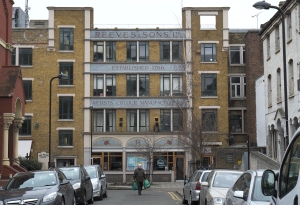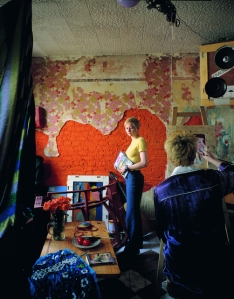Tom Hunter : The Way Home
As preparation for the talk I read an interview in Photomonitor by Katy Barron . Photomonitor is an on-line magazine that includes our own OCA tutors Jesse and Sharon Boothroyd amongst its contributors. Sharon was also our accompanying tutor and had organised the visit.
I had already seen Tom’s work in “Seduced by Art” at the National Gallery and, of course looked at his website
Two aspects struck me in particular from the Photomonitor interview concerning his attitude towards photography. The first concerns his latest pinhole work and how the lens “slowly absorbs the scene rather than grabbing or taking it” giving him time to talk with people. The second was about people’s attitudes towards Old Masters – “Rather like going to church where you have to bow to these great masters”, and how one can forget the context of a painting so that the subject matter becomes lost in the technical detail of the painting (I hope I’ve understood that right).
Tom has a casually relaxed style; is easy to listen to; engaging and obviously passionate about his work and the area where he lives. Basically, his talk covered the areas that have already been outlined in one of the essays on his website the difference, of course, is that listening to him speak made his journey come alive; not to mention the images he showed and explained to us. I can certainly understand how he succeeds so well in getting his subjects to co-operate with him.
He has spent a long time looking at his surroundings; exploring his own neighbourhood and using different ways to portray situations. What came through overall in his talk was certainly the way in which universal themes and situations have continued in their different forms and how they can be portrayed, in what I think of as a painterly manner, whilst using ‘ordinary’ people and their lives as a context, through the photographic medium . What’s interesting to me is that this can now be seen as experimental/conceptual rather than ‘copying/mimicking’ as it might have seemed earlier in the history of photography. It seems to me that, on the whole, anything goes in photography so long as you can justify it comprehensively and articulately using the appropriate method of communication.
The other aspect that struck me was that continual search as a photographer for new ways of looking at things and yet retaining some beliefs/attitudes/passions as a core. A humanitarian ethos of respect for others and believing in the importance of engaging his subjects in his work. Being welded to Hackney and its people and wanting to show that ordinary people have their own unique stories which are worth the telling. There is also his use of an artistic approach to raise contentious issues and engage in a fight with local authorities. This is an interesting aspect particularly at the moment having discussed Martha Rosler’s views on documentary in the recent OCA Thames Valley group session. John made a comment on my previous post here concerning the question of whether documentary should appear on a gallery wall and Allan Sekula’s statement that
Documentary is thought to be art when it transcends its reference to the world, when the work can be regarded first and foremost, as an act of self-expression on the part of the artist” (A. Sekula, 1984, p.58)
How does that fit with Tom Hunter’s work? To me his work is art as well as documentary. He points to the universality of contemporary stories; bases them in his own neighbourhood and has found his own creative voice. His work appears on gallery walls and in museums. At the same time his images have achieved positive change.
His Degree Show in 1994 was The Ghetto. He and others were trying to save their squatted street in Hackney from demolition and themselves from eviction. He produced a 3D model of the street (in his words to us his neighbourhood became an art sculpture). He had begun using a medium format camera and produced transparencies whose effect resembled being transported into a cathedral with it stained glass windows. These transparencies were placed in the model. His tutors encouraged him to look at Dutch painting and he discovered Vermeer and his use of light and the painting of ordinary people. After travelling around Europe for a couple of years he went back to his squatting neighbourhood. Possession orders were again being issued, and he returned to Vermeer in his quest to raise the status of the fight with the Local Authorities.
One of his neighbours who had received an eviction order became Woman Reading a Possession Order from Hunter’s series Persons Unknown
Woman Reading a Possession Order (1997) (c) Tom Hunter
Reproduced with his permission
the starting point was Vermeer’s A Girl Reading a Letter at an Open Window .
Another example from the same series is the Art of Squatting .
The Art of Squatting (1997) (c) Tom Hunter
Reproduced with his permission
The Art of Painting (1665-67) was known as Vermeer’s favourite piece. Vermeer’s painting has cloth/tapestry on the wall – probably a map of the Netherlands. Hunter’s reworking has torn wallpaper that, to me, looks the same shape as the map. Subsequently he has taken influences from other artists and lives of artists such as Millais and the author Thomas Hardy. Hardy based all his stories on true stories and Tom Hunter started to collect people’s stories from the Hackney Gazette. He noticed that the same stories repeated themselves over and over again and re-enacted some of them in his series Living in Hell and other Stories
This works for me as an artist in contextualizing my work, giving it multiple layers and asking classical and contemporary viewers alike to question art’s relationship to society (2012, p. 7)
He has wanted both to document life around him; raise issues and represent the beauty and dignity of ordinary people and his surroundings. One of the questions raised during the talk was whether he thought his views had become compromised by moving from documentary to a more elitist area, being shown in the National Gallery or Saatchi Gallery for instance. Tom Hunter’s response was that he had wanted to involve the whole society in a debate about ways of living and being shown in these environments gave him the opportunity to put his points of view to a wider audience. Making scenes look beautiful (as he does) will bring people in from all sorts of backgrounds. In terms of ‘realism’ he described how photojournalists may also compose and stage their images; instructing people to “Move here. Move there”.
I wrote above about Tom Hunter’s easy and relaxed way of talking to us. His view is that you have to prove to people that you’re honest and straightforward and won’t be “taking the piss”. He said there is an art in the way you talk to people. If they say, “No”, then that’s an opportunity to explain and engage them. I think that’s a good rule to follow. I also hope that he doesn’t lose this as he becomes more famous. I don’t think he will somehow.
References
Hunter, T (2012) Tom Hunter : The Way Home, Hatje Cantz Verlag, Germany
Sekula, A Photography against the grain: essays and photo works, 1973-1983, Press of the Nova Scotia College of Art and Design, Halifax, 1984.
http://skd-online-collection.skd.museum/en/contents/showSearch?id=415429
http://www.khm.at/en/visit/exhibitions/past-exhibitions/2010/vermeer-the-art-of-painting/
http://www.franshalsmuseum.nl/en/collection/search-collection/the-art-of-squatting-1537/
http://www.tomhunter.org/the-way-home-book-introduction-essay-by-tom-hunter/




Have you been storing this one away for a rainy day? Great that you have updated your thoughts on TH in the light of recent discussions. So the question is how does TH’s work square with Sekula’s notion of when documentary becomes art? My impression is that TH regards himself as an artist and not as a documentary photographer and his work questions why art is reserved for a rarified group of well educated aficionados?
I’m just so late with the write-ups and I must find a better process on my next Module. At least I always have all the handwritten notes etc that can be placed in my paper log. In fact the paper log is much thicker than for AOP!
I was trying to answer your last sentence. He did say that he thought being in galleries brought his work to a wider audience. Also if you think about the earlier Hackney work it did bring changes. If you look at it another way, his work of that kind is radical because it gets people looking at the work first because of it’s beauty and cultural references but then they start to ask questions about it. He is making statements about society unlike Jeff Wall I think.
Maybe at some point we can debate this in the TV group if not elsewhere.
Jeff Wall also deals with vernacular situations in his work but his approach is based on constructing fictional realities. He presents everyday events as allegorical stories. History, religious and genre painting had similar aims but most often of course the subjects were not everyday people, rather kings, queens, saints, gods and so on…. Wall’s use of large backlit transparency panels was his way of matching the impact of large oil paintings in the medium of photography.
i think there may have been a change in the way in which TH works. His early work the Ghetto Series was essentially a set of environmental portraits showing the real face of the people in the ghetto. His use of the large format camera in a way elevated the status of his subjects and their response to this may well have influenced how they come over in the portraits. The process of using the large format is slow (as you have experienced) and I think this also helped him to create a set of calm, dignified portraits. His mode of presentation in the form of the model is however significantly different from the large format photographs (emulating large format paintings) of his later work. The fact that he can sell the individual photographs is an important consideration here (I would guess around £5000 to £10000 per limited edition print)…
So perhaps it is more instructive to look at his work on a series by series basis rather than trying to categorise the whole.
Pingback: “Theatres of the Real” and the ‘Uncanny’ | Context and Narrative